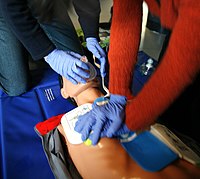
Photo from wikipedia
Objective: Interruptions in chest compressions during treatment of out-of-hospital cardiac arrest are associated with lower likelihood of successful resuscitation. Real-time automated detection of chest compressions may improve CPR administration during… Click to show full abstract
Objective: Interruptions in chest compressions during treatment of out-of-hospital cardiac arrest are associated with lower likelihood of successful resuscitation. Real-time automated detection of chest compressions may improve CPR administration during resuscitation, and could facilitate application of next-generation ECG algorithms that employ different parameters depending on compression state. In contrast to accelerometer sensors, transthoracic impedance (TTI) is commonly acquired by defibrillators. We sought to develop and evaluate the performance of a TTI-based algorithm to automatically detect chest compressions. Methods: Five-second TTI segments were collected from patients with out-of-hospital cardiac arrest treated by one of four defibrillator models. Segments with and without chest compressions were collected prior to each of the first four defibrillation shocks (when available) from each case. Patients were divided randomly into 40% training and 60% validation groups. From the training segments, we identified spectral and time-domain features of the TTI associated with compressions. We used logistic regression to predict compression state from these features. Performance was measured by sensitivity and specificity in the validation set. The relationship between performance and TTI segment length was also evaluated. Results: The algorithm was trained using 1859 segments from 460 training patients. Validation sensitivity and specificity were >98% using 2727 segments from 691 validation patients. Validation performance was significantly reduced using segments shorter than 3.2 s. Conclusions: A novel method can reliably detect the presence of chest compressions using TTI. These results suggest potential to provide real-time feedback in order to improve CPR performance or facilitate next-generation ECG rhythm algorithms during resuscitation.
Journal Title: IEEE Journal of Biomedical and Health Informatics
Year Published: 2020
Link to full text (if available)
Share on Social Media: Sign Up to like & get
recommendations!